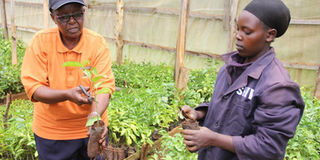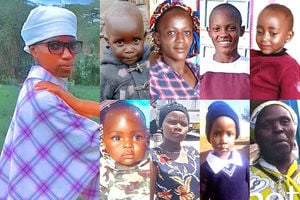I have found wealth in fruit seedlings

Irene Kalamai (left), a farmer in Chepterit, Nandi County and her employee Nelly Songok tend to grafted passion fruit seedlings in a greenhouse where her group, Chepterit Community Based Organisation operates from on July 08, 2014. JARED NYATAYA (Eldoret).
What you need to know:
- Grafting is done when the seedlings are two months old. The stem of the stock is cut 15cm from the base.
- The seeds should be obtained from disease-free fully ripened fruits. He emphasises that proper procedure of removal of juice sacs, washing and fermentation for three to four days should be followed for uniform germination.
Irene Kalamai has been a nurse throughout her adult life.
She knows what it takes to make people grow healthy or recover from sickness and regain their productivity.
“It is all about tender care. You give people healthy food, they won’t get sick,” says the nurse.
It is this knowledge that she has transferred to her passion fruits venture in Kapsabet town.
Irene, a retired nurse, grows passion fruit seedlings in three 15 by 15 metres greenhouses.
In one of the greenhouses, there is a 4 by 4 metres special room covered by a polythene paper, which she calls the “curing room”.
The room is humid. It is here that Irene nurses grafted seedlings for 14 days. The operation involves cutting stock from one plant and scion from another and joining them.
“Conditions in the little room are optimum for an injured plant to heal. Survival rate is 98 per cent,” says the nurse whose hard work earned her a presidential commendation in 2006.
Kalamai has a passion for growing passion fruits.
This passion made her to mobilise 45 farmers and register a community institution named Chepterit Horticultural Growers Organisation in 2010.
The group secured a loan of Sh160,000 and bought 4,000 seedlings, which they shared. Unknown to them, the seeds had Fusariam wilt, a fungal disease that killed all of them. She had to repay the loan herself as most members of the group left to venture into other activities.
With other members of the group having left, Irene now engages in the business alone. She prepares her seedbeds one month before planting. She digs the top soil from her farm, disinfects it by spreading in the sun for two days before mixing with farm yard manure and DAP.
She transports half the soil to the seedling chamber where she plants seeds from Horticultural Crop Development Authority (HCDA). The other half is packed in small tubes for planting grafted seedlings.
“During grafting, the stock and scion are needed. Stock is obtained from seeds from HCDA whereas the scion is sourced from an orchard, where a farmer picks healthy fruits, crushes and sieves them. The filtrates make good juice while the residue is treated, then planted as scions.”
She says the yellow passion fruit variety has good rooting ability while the purple ones are good for making scions.
Grafting
Grafting is done when the seedlings are two months old. The stem of the stock is cut 15cm from the base.
The scion on the other hand is cut at five to 10 cm from the top. The two are then tightly tied together with a polythene tape and carefully transferred to the curing chamber for 14 days.
“After seven months, the seedlings are ready for sale at Sh40 each.”
When Seeds of Gold visited Irene, she had 15,000 seedlings ready for sale this planting season.
Amos Ego, a plant breeder at University of Eldoret, says “the success of passion fruit (Passiflora edulis) farming starts from seed extraction and nursery establishment.”
The seeds should be obtained from disease-free fully ripened fruits. He emphasises that proper procedure of removal of juice sacs, washing and fermentation for three to four days should be followed for uniform germination.
“Soil medium composition, sterilisation of soil and cutting tools to reduce chances of cross-transmission of diseases, nursery site selection and grafting techniques are some of the major steps of producing disease-free planting materials.”
“Net houses should be used to protect the seedlings from insects which are vectors of major diseases like Passion woodiness virus.”




